Enrico Zovato
A Toolkit for Joint Speaker Diarization and Identification with Application to Speaker-Attributed ASR
Sep 09, 2024

Abstract:We present a modular toolkit to perform joint speaker diarization and speaker identification. The toolkit can leverage on multiple models and algorithms which are defined in a configuration file. Such flexibility allows our system to work properly in various conditions (e.g., multiple registered speakers' sets, acoustic conditions and languages) and across application domains (e.g. media monitoring, institutional, speech analytics). In this demonstration we show a practical use-case in which speaker-related information is used jointly with automatic speech recognition engines to generate speaker-attributed transcriptions. To achieve that, we employ a user-friendly web-based interface to process audio and video inputs with the chosen configuration.
* Show and Tell paper. Presented at Interspeech 2024
Exploring Spoken Language Identification Strategies for Automatic Transcription of Multilingual Broadcast and Institutional Speech
Jun 13, 2024


Abstract:This paper addresses spoken language identification (SLI) and speech recognition of multilingual broadcast and institutional speech, real application scenarios that have been rarely addressed in the SLI literature. Observing that in these domains language changes are mostly associated with speaker changes, we propose a cascaded system consisting of speaker diarization and language identification and compare it with more traditional language identification and language diarization systems. Results show that the proposed system often achieves lower language classification and language diarization error rates (up to 10% relative language diarization error reduction and 60% relative language confusion reduction) and leads to lower WERs on multilingual test sets (more than 8% relative WER reduction), while at the same time does not negatively affect speech recognition on monolingual audio (with an absolute WER increase between 0.1% and 0.7% w.r.t. monolingual ASR).
An Experimental Review of Speaker Diarization methods with application to Two-Speaker Conversational Telephone Speech recordings
May 29, 2023Abstract:We performed an experimental review of current diarization systems for the conversational telephone speech (CTS) domain. In detail, we considered a total of eight different algorithms belonging to clustering-based, end-to-end neural diarization (EEND), and speech separation guided diarization (SSGD) paradigms. We studied the inference-time computational requirements and diarization accuracy on four CTS datasets with different characteristics and languages. We found that, among all methods considered, EEND-vector clustering (EEND-VC) offers the best trade-off in terms of computing requirements and performance. More in general, EEND models have been found to be lighter and faster in inference compared to clustering-based methods. However, they also require a large amount of diarization-oriented annotated data. In particular EEND-VC performance in our experiments degraded when the dataset size was reduced, whereas self-attentive EEND (SA-EEND) was less affected. We also found that SA-EEND gives less consistent results among all the datasets compared to EEND-VC, with its performance degrading on long conversations with high speech sparsity. Clustering-based diarization systems, and in particular VBx, instead have more consistent performance compared to SA-EEND but are outperformed by EEND-VC. The gap with respect to this latter is reduced when overlap-aware clustering methods are considered. SSGD is the most computationally demanding method, but it could be convenient if speech recognition has to be performed. Its performance is close to SA-EEND but degrades significantly when the training and inference data characteristics are less matched.
End-to-End Integration of Speech Separation and Voice Activity Detection for Low-Latency Diarization of Telephone Conversations
Mar 21, 2023Abstract:Recent works show that speech separation guided diarization (SSGD) is an increasingly promising direction, mainly thanks to the recent progress in speech separation. It performs diarization by first separating the speakers and then applying voice activity detection (VAD) on each separated stream. In this work we conduct an in-depth study of SSGD in the conversational telephone speech (CTS) domain, focusing mainly on low-latency streaming diarization applications. We consider three state-of-the-art speech separation (SSep) algorithms and study their performance both in online and offline scenarios, considering non-causal and causal implementations as well as continuous SSep (CSS) windowed inference. We compare different SSGD algorithms on two widely used CTS datasets: CALLHOME and Fisher Corpus (Part 1 and 2) and evaluate both separation and diarization performance. To improve performance, a novel, causal and computationally efficient leakage removal algorithm is proposed, which significantly decreases false alarms. We also explore, for the first time, fully end-to-end SSGD integration between SSep and VAD modules. Crucially, this enables fine-tuning on real-world data for which oracle speakers sources are not available. In particular, our best model achieves 8.8% DER on CALLHOME, which outperforms the current state-of-the-art end-to-end neural diarization model, despite being trained on an order of magnitude less data and having significantly lower latency, i.e., 0.1 vs. 1 seconds. Finally, we also show that the separated signals can be readily used also for automatic speech recognition, reaching performance close to using oracle sources in some configurations.
Conversational Speech Separation: an Evaluation Study for Streaming Applications
May 31, 2022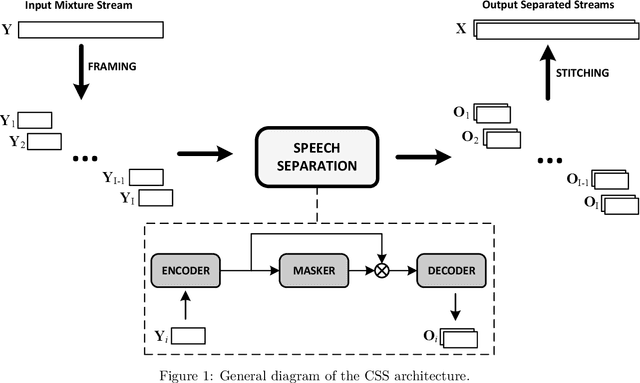

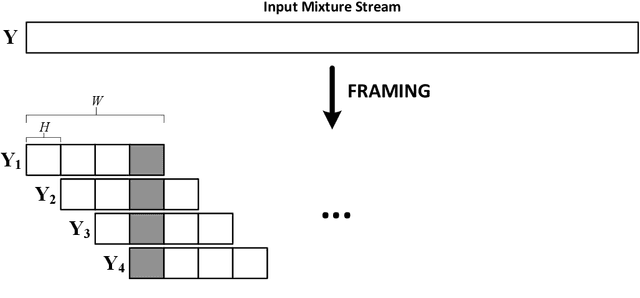

Abstract:Continuous speech separation (CSS) is a recently proposed framework which aims at separating each speaker from an input mixture signal in a streaming fashion. Hereafter we perform an evaluation study on practical design considerations for a CSS system, addressing important aspects which have been neglected in recent works. In particular, we focus on the trade-off between separation performance, computational requirements and output latency showing how an offline separation algorithm can be used to perform CSS with a desired latency. We carry out an extensive analysis on the choice of CSS processing window size and hop size on sparsely overlapped data. We find out that the best trade-off between computational burden and performance is obtained for a window of 5 s.
Leveraging Speech Separation for Conversational Telephone Speaker Diarization
Apr 05, 2022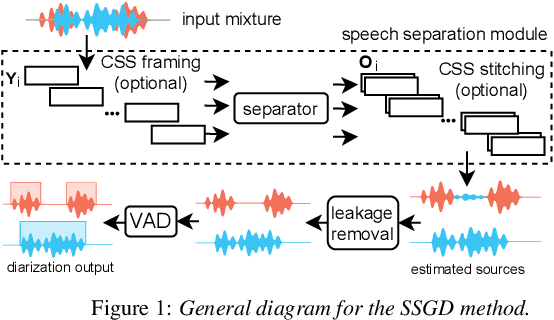
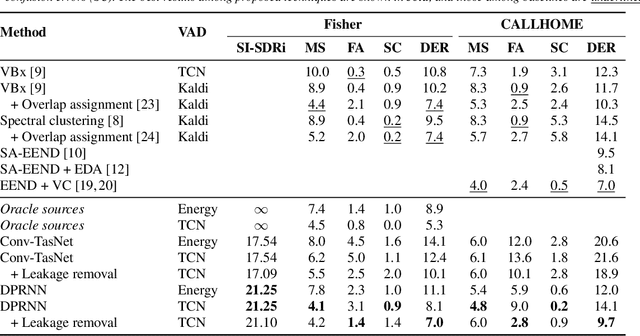
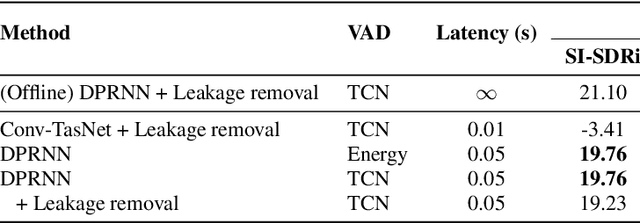
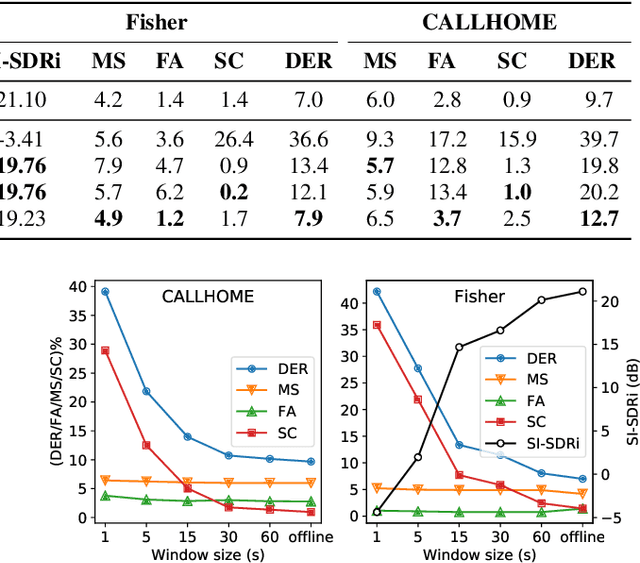
Abstract:Speech separation and speaker diarization have strong similarities. In particular with respect to end-to-end neural diarization (EEND) methods. Separation aims at extracting each speaker from overlapped speech, while diarization identifies time boundaries of speech segments produced by the same speaker. In this paper, we carry out an analysis of the use of speech separation guided diarization (SSGD) where diarization is performed simply by separating the speakers signals and applying voice activity detection. In particular we compare two speech separation (SSep) models, both in offline and online settings. In the online setting we consider both the use of continuous source separation (CSS) and causal SSep models architectures. As an additional contribution, we show a simple post-processing algorithm which reduces significantly the false alarm errors of a SSGD pipeline. We perform our experiments on Fisher Corpus Part 1 and CALLHOME datasets evaluating both separation and diarization metrics. Notably, without fine-tuning, our SSGD DPRNN-based online model achieves 12.7% DER on CALLHOME, comparable with state-of-the-art EEND models despite having considerably lower latency, i.e., 50 ms vs 1 s.
Voice Cloning: a Multi-Speaker Text-to-Speech Synthesis Approach based on Transfer Learning
Feb 10, 2021

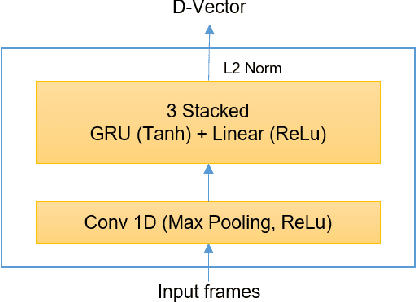
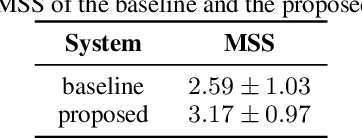
Abstract:Deep learning models are becoming predominant in many fields of machine learning. Text-to-Speech (TTS), the process of synthesizing artificial speech from text, is no exception. To this end, a deep neural network is usually trained using a corpus of several hours of recorded speech from a single speaker. Trying to produce the voice of a speaker other than the one learned is expensive and requires large effort since it is necessary to record a new dataset and retrain the model. This is the main reason why the TTS models are usually single speaker. The proposed approach has the goal to overcome these limitations trying to obtain a system which is able to model a multi-speaker acoustic space. This allows the generation of speech audio similar to the voice of different target speakers, even if they were not observed during the training phase.
 Add to Chrome
Add to Chrome Add to Firefox
Add to Firefox Add to Edge
Add to Edge